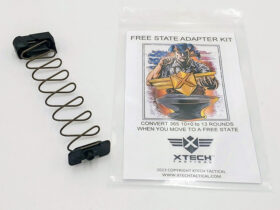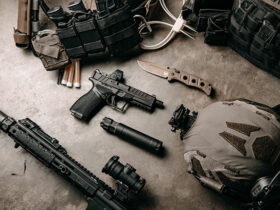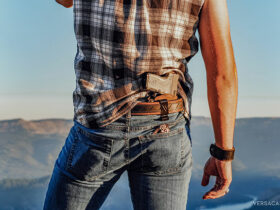I am a strong proponent of consistency in everyday carry. Carrying the same gun in the same position is ideal to build muscle memory and familiarity. This makes the draw stroke and presentation second nature. However, as the weather turns cold, and we start layering up to go out, there are some ways you can skillfully adapt your EDC.
Carry Gun
One of the main considerations is whether you want to change your carry pistol. Many people choose to “up gun” in the winter because the added layers make concealment easier. With a sweater or jacket on, the handgun prints less. Additionally, the ‘shorts’ crowd are all wearing pants, and a good gun belt helps manage the increased weight.

Now you may be asking, “But why, am I in any more danger than before?” Not necessarily, however, a larger handgun is easier to shoot and provides you with more capabilities. They tend to have a higher magazine capacity and improved sights. They are also easier to retrieve on the draw and handle larger calibers better.
Going with a larger caliber typically gives you improved penetration and ballistic performance. This is more of a concern in winter with thicker jackets and multiple layers of clothing. It will also create a larger wound channel, leading to more tissue damage and blood loss.
If you typically carry something like a M&P Shield, you could move up to a M&P Compact in the winter. You could stick with the same caliber or move from a 9mm to a .40 S&W or .45 ACP. This gives you a familiar platform to operate with a bit more capabilities. The same goes for Glock and other manufacturers, you could go from something like a G43 or G26 to a G19 or G17. If you carry a revolver, you may transition from a J-Frame to K-Frame, or possibly even larger. You can get an extra round in and go with a longer barrel for a ballistic advantage.
If you would like to keep the same gun, there are still ways you can adapt it for better cold weather carry. If you typically carry something subcompact, you could keep the same gun but carry it with a larger magazine inserted for a longer grip. A modular design, such as the SIG P365 can be converted from the standard frame to the longer XL frame along with the improved magazine capacity. If your handgun has replaceable grips, consider swapping wood or smooth plastic for some high-traction G10.
If a larger sidearm is absolutely out of the picture for one reason or another, perhaps going with a small snub-nose revolver is just the ticket. Stored in a jacket pocket, you have quick access and can place your hand on it without drawing attention. You will not get the benefit of more rounds and improved ballistic performance, but you will retain the light weight and small overall footprint you require. After all, one of the main considerations is access.

Maybe change loads to something hotter that’s designed for greater penetration. No, your holiday sweater and Carhart isn’t Level IV plates, but there’s no denying that layers of clothing hinders proper bullet penetration and expansion. Hornady makes a polymer flex tip jacketed hollow point that prevents early expansion. This allows the bullet to properly penetrate clothing layers before expanding in the body.
Carry Position/Draw Method
One of the main benefits to carrying a larger pistol is the longer grip and improved controls. This makes the gun easier to access under clothing and grab during the draw stroke. It also makes it easier to operate and shoot. This is especially important in the cold when your fine motor skills will be impaired (also by the shock and adrenaline of a self-defense situation).
Practice your draw stroke with all your outer layers on. Depending on how you carry, the more clothing you have on, the more your draw is obscured. If you carry inside the waistband (IWB), you may experience more of an issue. Consider switching to an outside the waistband (OWB) holster or a shoulder rig. This will improve your access to the pistol. Because printing is less of a concern, more people can get away with concealing the handgun using this method.
If possible, keep the same battery of arms between firearms and holster systems. We want to minimize the adjustments we must make to retain as much muscle memory as possible. Four or five o’clock IWB carry presents much the same as OWB in the same position, you will just have easier access to the pistol. This cannot always be accomplished. For instance, you may find IWB works in the summer, and a shoulder holster works in the winter. Those are very different carry methods and will each require unique practice and training for the draw stroke and presentation.

Range Work
You need to test your gear. You may find that the exposed hammer on your 1911 snags your cable-knit sweater on the draw. It’d be a shame to find that out on the bus at 2 a.m. This is why it’s important to train with your gear in the manner it will actually be used.
If you wear gloves, practice with them. Are you planning on yanking them off before going for your pistol or shooting with them on? Gloves will lower your tactile sensitivity, which may require some adjustment. A good pair of black shooting gloves is discreet enough to be worn out and about, while providing positive grip and articulation, should you need to use your firearm.
If you tend to stick to indoor ranges, try shooting outdoors for a change. Feel what it’s like to shoot in the cold with the wind in your face. Your hands will either be impaired by the cold or restricted by gloves. Experience the feeling of operating the controls, reloading, clearing malfunctions.
As you get colder, you will lose more motor function and begin shivering. This will make aiming and getting accurate shots off more difficult. Now, this is an extreme example scenario, as most people likely don’t spend extended periods of time out in the cold during a day to day basis. However, some do (depending on job, transportation, and environment).

Further, snow reflects light, which makes your surroundings brighter. This puts a strain on your eyes and makes it harder to see. If you live in areas that experience frequent snow, be prepared for this and consider adding in some sunglasses to your EDC, if you don’t already.
Additional Gear
In addition to adapting your carry gun, there’s some extra gear you should consider packing. With the decreased chance of printing and the added pockets, it’s easier to get away with more gear. A spare magazine (or two) is good insurance in case of a malfunction or should you run dry. Speedstrips and speedloaders for revolvers work too. An OWB carrier or shoulder rig works well, but so does a jacket pocket.
I’m an advocate of carrying a nice blade for utility and backup defense. For quick access, you can’t beat a fixed blade. Maybe a backup gun (BUG) is now a realistic option for you. It’s easy to toss a S&W Airweight into a coat pocket. (The coat pocket is an example. Do not throw all your gear into a dozen pockets for your jacket to become an ungainly mess that you take off — along with your gear — the first chance you get.)

Consider keeping some hand warmers in your pockets if you’re going to be out for an extended period of time. It will help keep your fingers nimble and dexterity up.
Don’t get me wrong. I’m not for change for the sake of change. This is more adapting a baseline of what you know works for you to better suit your current environment.
What do you carry in the winter? Does your EDC change with the season and environment? How? Share your thoughts in the Comment section.









Leave a Reply